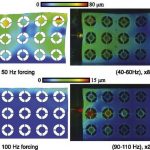Publications
Wadhwa, Neal; Chen, Justin G; Sellon, Jonathan B; Wei, Donglai; Rubinstein, Michael; Ghaffari, Roozbeh; Freeman, Dennis M; Büyüköztürk, Oral; Wang, Pai; Sun, Sijie; Kang, Sung Hoon; Bertoldi, Katia; Durand, Frédo; Freeman, William T
Motion microscopy for visualizing and quantifying small motions Journal Article
In: Proceedings of the National Academy of Sciences, vol. 114, pp. 11639–11644, 2017.
@article{Wadhwa16102017,
title = {Motion microscopy for visualizing and quantifying small motions},
author = {Neal Wadhwa and Justin G Chen and Jonathan B Sellon and Donglai Wei and Michael Rubinstein and Roozbeh Ghaffari and Dennis M Freeman and Oral Büyüköztürk and Pai Wang and Sijie Sun and Sung Hoon Kang and Katia Bertoldi and Frédo Durand and William T Freeman},
url = {http://www.pnas.org/content/early/2017/10/11/1703715114.abstract},
doi = {10.1073/pnas.1703715114},
year = {2017},
date = {2017-10-16},
journal = {Proceedings of the National Academy of Sciences},
volume = {114},
pages = {11639–11644},
abstract = {Although the human visual system is remarkable at perceiving and interpreting motions, it has limited sensitivity, and we cannot see motions that are smaller than some threshold. Although difficult to visualize, tiny motions below this threshold are important and can reveal physical mechanisms, or be precursors to large motions in the case of mechanical failure. Here, we present a âmotion microscope,â a computational tool that quantifies tiny motions in videos and then visualizes them by producing a new video in which the motions are made large enough to see. Three scientific visualizations are shown, spanning macroscopic to nanoscopic length scales. They are the resonant vibrations of a bridge demonstrating simultaneous spatial and temporal modal analysis, micrometer vibrations of a metamaterial demonstrating wave propagation through an elastic matrix with embedded resonating units, and nanometer motions of an extracellular tissue found in the inner ear demonstrating a mechanism of frequency separation in hearing. In these instances, the motion microscope uncovers hidden dynamics over a variety of length scales, leading to the discovery of previously unknown phenomena.},
keywords = {},
pubstate = {published},
tppubtype = {article}
}
Note: Send e-mail to Prof. Kang at shkang@jhu.edu if you need a pdf file of the papers below.
2017

Wadhwa, Neal; Chen, Justin G; Sellon, Jonathan B; Wei, Donglai; Rubinstein, Michael; Ghaffari, Roozbeh; Freeman, Dennis M; Büyüköztürk, Oral; Wang, Pai; Sun, Sijie; Kang, Sung Hoon; Bertoldi, Katia; Durand, Frédo; Freeman, William T
Motion microscopy for visualizing and quantifying small motions Journal Article
In: Proceedings of the National Academy of Sciences, vol. 114, pp. 11639–11644, 2017.
Abstract | Links | BibTeX | Tags: dynamic, meta material, motion amplification
@article{Wadhwa16102017,
title = {Motion microscopy for visualizing and quantifying small motions},
author = {Neal Wadhwa and Justin G Chen and Jonathan B Sellon and Donglai Wei and Michael Rubinstein and Roozbeh Ghaffari and Dennis M Freeman and Oral Büyüköztürk and Pai Wang and Sijie Sun and Sung Hoon Kang and Katia Bertoldi and Frédo Durand and William T Freeman},
url = {http://www.pnas.org/content/early/2017/10/11/1703715114.abstract},
doi = {10.1073/pnas.1703715114},
year = {2017},
date = {2017-10-16},
journal = {Proceedings of the National Academy of Sciences},
volume = {114},
pages = {11639–11644},
abstract = {Although the human visual system is remarkable at perceiving and interpreting motions, it has limited sensitivity, and we cannot see motions that are smaller than some threshold. Although difficult to visualize, tiny motions below this threshold are important and can reveal physical mechanisms, or be precursors to large motions in the case of mechanical failure. Here, we present a âmotion microscope,â a computational tool that quantifies tiny motions in videos and then visualizes them by producing a new video in which the motions are made large enough to see. Three scientific visualizations are shown, spanning macroscopic to nanoscopic length scales. They are the resonant vibrations of a bridge demonstrating simultaneous spatial and temporal modal analysis, micrometer vibrations of a metamaterial demonstrating wave propagation through an elastic matrix with embedded resonating units, and nanometer motions of an extracellular tissue found in the inner ear demonstrating a mechanism of frequency separation in hearing. In these instances, the motion microscope uncovers hidden dynamics over a variety of length scales, leading to the discovery of previously unknown phenomena.},
keywords = {dynamic, meta material, motion amplification},
pubstate = {published},
tppubtype = {article}
}